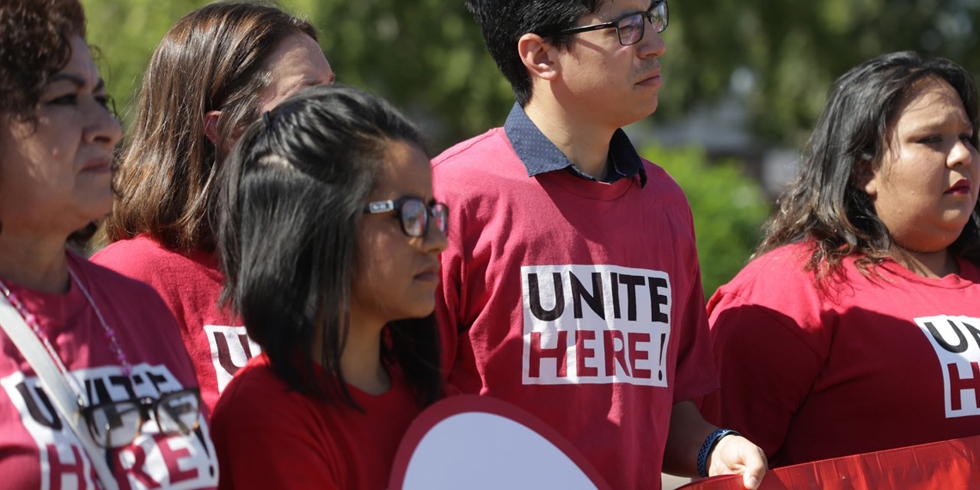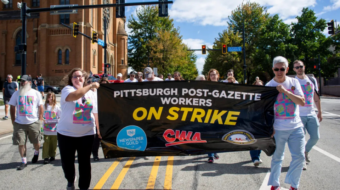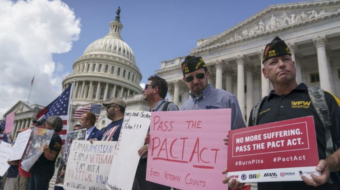
The Democratic Party released its Better Deal platform last year that included a call for a higher minimum wage, better jobs, and worker training. Conspicuously absent, however, was any mention of unions. This was quite a stunning departure from the original New Deal that had unions and labor organizing at its very core.
More recently, the Dems added a new plank that focuses on labor law reform, under the banner of “Give Workers the Freedom to Negotiate a Better Deal.” While no one expects the proposals to pass any time soon, their inclusion signals the Democrats may wrap workers’ freedom to organize into their 2019 platform for legislation, if they take control of Capitol Hill.
Will the Democrats stick with labor law reform this time around? For women workers’ sake, let’s hope so.
After all, workers’ right to freely form unions and bargain collectively is a gender justice issue. Unions help women close the wage gap, rise out of poverty, and address power issues on the job.
As I show in my book, Knocking On Labor’s Door, women made a broad-based push to join unions in the 1970s. During that decade, a whopping 12 million more women entered the nation’s workplaces, many gaining new access to the nation’s jobs following the 1964 Civil Rights Act.
As they came into new workplaces, women of all backgrounds and men of color powered a fresh wave of union organizing in the nation’s workplaces, aiming to ensure that their new jobs were good jobs. Finally, it seemed that they too would have full access to the New Deal’s full economic promise.
Employers, however, ramped up their resistance to union organizing, and began to bend and break the law at new levels. The number of unfair labor practices, or instances of employer law breaking, doubled during the decade. The employer opposition was remarkably effective; while workers had won 80 percent of their union elections in the 1940s, by the late 1970s they were winning less than half.
That trend has continued today: 96 percent of employers fight workers’ efforts to unionize, according to research by Kate Bronfenbrenner at Cornell University, half threaten to close up shop if employees unionize, and about a third fire union supporters.
Despite employer resistance, women did steadily increase their membership in unions. In 1960, only 18 percent of union members were women. By 1984, that figure was 34 percent. Today, women make up nearly half of union members, and are on track to be the majority of union members by 2025. But employer opposition to new worker organizing undergirds labor unions’ dwindling membership levels. Women today are a greater proportion of a smaller pool of union members.
Unions make a real difference for those women who manage to successfully organize. Union women earn 13 percent more than women with similar jobs who are without a union, are more likely to have employer-provided health care, and are 54 percent more likely to have an employer-provided pension. That kind of economic difference can be a game changer when women hold two-thirds of the U.S.’s lowest-paying jobs.
Joining a union gives women more power over their working conditions, such as schedules and hours; lots of working-class mothers, for example, cycle through a string of bad jobs with unpredictable schedules. Union women have an extra tool in their toolbox for dealing with a manager’s sexual harassment.
Women who work as janitors in California, for instance, often find themselves alone at night in empty buildings alongside male managers. The United Service Workers West recently won contract language and a law requiring cleaning and security employers to offer training on sexual harassme
The Democrats’ belated collection of legislative fixes would help limit employers’ ability to squash workers’ union organizing efforts. When employers force workers into mandatory meetings against the union, the Democrats’ new rules would have the election results thrown out.
Right now, if employers break the law, there are no penalties. They just have to hang a blue and white sign saying they broke the law. The new plank would impose real penalties that could give the law a bit more teeth.
The plank also anticipates Congress could overturn the Obama-era joint employer standard, issued in the Browning-Ferris NLRB decision, that holds parent companies accountable for their sub-contractors’ behavior. The House passed legislation on Nov. 7 to overturn the joint standard, with support from eight Democrats. The legislation still must clear the Senate, but the new Trump-named GOP majority on the NLRB beat them to it, tossing out Browning-Ferris in December.
The Democrats’ new labor plank also anticipates a Supreme Court decision in Janus v. AFSCME that could cripple unions by ending “agency fees” covering representation costs in public sector union contracts nationwide; experts predict this case will be a watershed moment for the labor movement.
The Better Deal would ban so-called “right-to-work” laws altogether, and provide public sector workers with the same rights to collectively bargain as workers in the private sector.
When the 2019 debate heats up regarding the Democrats’ full plank, union organizing is likely to be viewed as a special interest issue impacting only labor unions. In fact, workers’ right to form a union is one of the key working-class women’s issue of the twenty-first century, and a “Better Deal” that drops this issue is a very bad deal indeed for the nation’s working women.
Lane Windham is associate director of The Kalmanowitz Center for Labor and the Working Poor at Georgetown University and a former top AFL-CIO communications staffer. This op-ed first appeared in Gender Policy Report. Used by permission.










